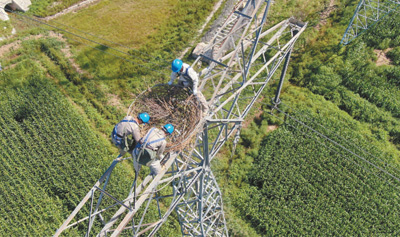China enhances bird conservation with artificial nest initiative for biodiversity protection
China stands as a nation rich in avian diversity, playing a pivotal role as a migratory conduit for various bird species. Four of the nine major global migratory bird routes pass through the country.

Staff members of the State Grid Corporation of China build an artificial bird nest in a safe area atop a power transmission tower. (Photo courtesy of the State Grid)
Yet, this natural wonder coexists with human development. Boasting more than 2.26 million kilometers of transmission lines of 35 kilovolts and above, China has the world's largest power system. In recent years, the country has taken steps to maintain a stable power supply while safeguarding the bird habitats that intertwine with these human-made structures.
This effort is vividly illustrated in the remote Ruoergai county, situated at an average altitude of about 3,500 meters in Aba Tibetan and Qiang Autonomous Prefecture in southwest China's Sichuan Province.
Here, birds of prey are often seen swooping down, tightly grasping their prey with sharp talons. After devouring their meal, they briefly hover in the air before descending onto a transmission tower. At the top of the tower, a nest made of rattan serves as the birds’ home.
Staff members of Aba Power Supply Company, a subsidiary of State Grid Sichuan Electric Power Company, built these artificial nests for birds of prey, such as falcons and black kites. The birds' hatching, feeding, and nurturing behaviors are recorded by high-definition cameras and transmitted to the company, providing valuable firsthand information to enhance bird protection.
Ruoergai Wetland, known for its lush water and grasslands, is home to more than 200 bird species. However, a significant problem has arisen: these birds have been constructing nests on transmission towers using wire and cow hair. This has led to bird-related faults becoming a frequent cause of line tripping, according to Liu Yong, head of the digitalization department at Aba Power Supply Company.
Compounding this issue is the grasslands' lack of tall trees, which has led many bird species to favor transmission towers as nesting sites. Previous attempts to deter birds from perching on the towers using bird-repellent devices were unsuccessful.
In response, Aba Power Supply Company undertook a proactive initiative in April 2023. The company installed 32 artificial bird nests and 14 sets of high-definition video equipment on a 110-kilovolt transmission line. The company also partially insulated its tower to prevent large birds from touching exposed live wires.
In 2016, the State Grid launched a public welfare project to foster harmonious coexistence between power transmission lines and birds.
The project has enabled researchers to study the behavior of rare birds of prey near power lines in plateau grasslands. Under this project, artificial bird nests labeled with a unique "house number" have been specifically installed for birds in various regions. This labeling facilitates convenient monitoring and management.
The project has expanded to plateau grassland areas in six provinces and autonomous regions, including Inner Mongolia Autonomous Region, Sichuan Province, Xizang Autonomous Region, Gansu Province, Qinghai Province, and Xinjiang Uygur Autonomous Region.
Over 5,200 artificial bird nests have been installed, leading to the hatching of nearly 4,000 young birds. This initiative has effectively protected the ecology of China's plateau grasslands.
Tiaozini Wetland in Yancheng city, in east China's Jiangsu Province, is a crucial stopover for migratory birds along the East Asia-Australasia Flyway. From November to June, numerous bird species, including the oriental white stork, a species under first-class state protection in China, spend winter here.
At State Grid Yancheng Power Supply Company's transmission operation and inspection center, a live video of a transmission tower near Tiaozini Wetland, over 90 kilometers away, was displayed on a large screen. On the screen, a pair of oriental white storks with white feathers and long, fiery-red legs, were seen building a new nest.
"This is the power grid biodiversity monitoring system. Whenever the camera detects a bird's nest, a drone is automatically dispatched to patrol and capture images. If evidence of rare bird species like the oriental white stork is found, our staff promptly install protective equipment at the site. This enhances protection effectiveness and reduces patrol costs," explained Song Yanqiu, a staff member of the technology digitization department at State Grid Yancheng Power Supply Company.
Song explained that the power grid biodiversity monitoring system has significantly enhanced the utilization rate of bird protection devices on transmission lines by approximately 20 percent, resulting in a reduction of over 5 million yuan ($700,225) in overall maintenance costs.
Since 2021, the State Grid has implemented the "Migratory Bird Lifeline" project at 23 sites across 18 provinces and cities. According to incomplete statistics, between 2022 and 2023, more than 580 oriental white stork chicks hatched in nests on the State Grid's transmission line towers.
Photos
Related Stories
- Improved ecological environment along Fenhe River attracts migratory birds
- Pakistani student contributes to China's migratory bird conservation efforts
- Areas around Poyang Lake thrive on bird-watching tourism
- Nature reserve in China's Hunan sees migratory bird population surge
- ‘World's reddest bird’ appears in Nanning, S China's Guangxi
- Migratory birds seen at coastal wetlands in Tangshan, N China
Copyright © 2024 People's Daily Online. All Rights Reserved.









